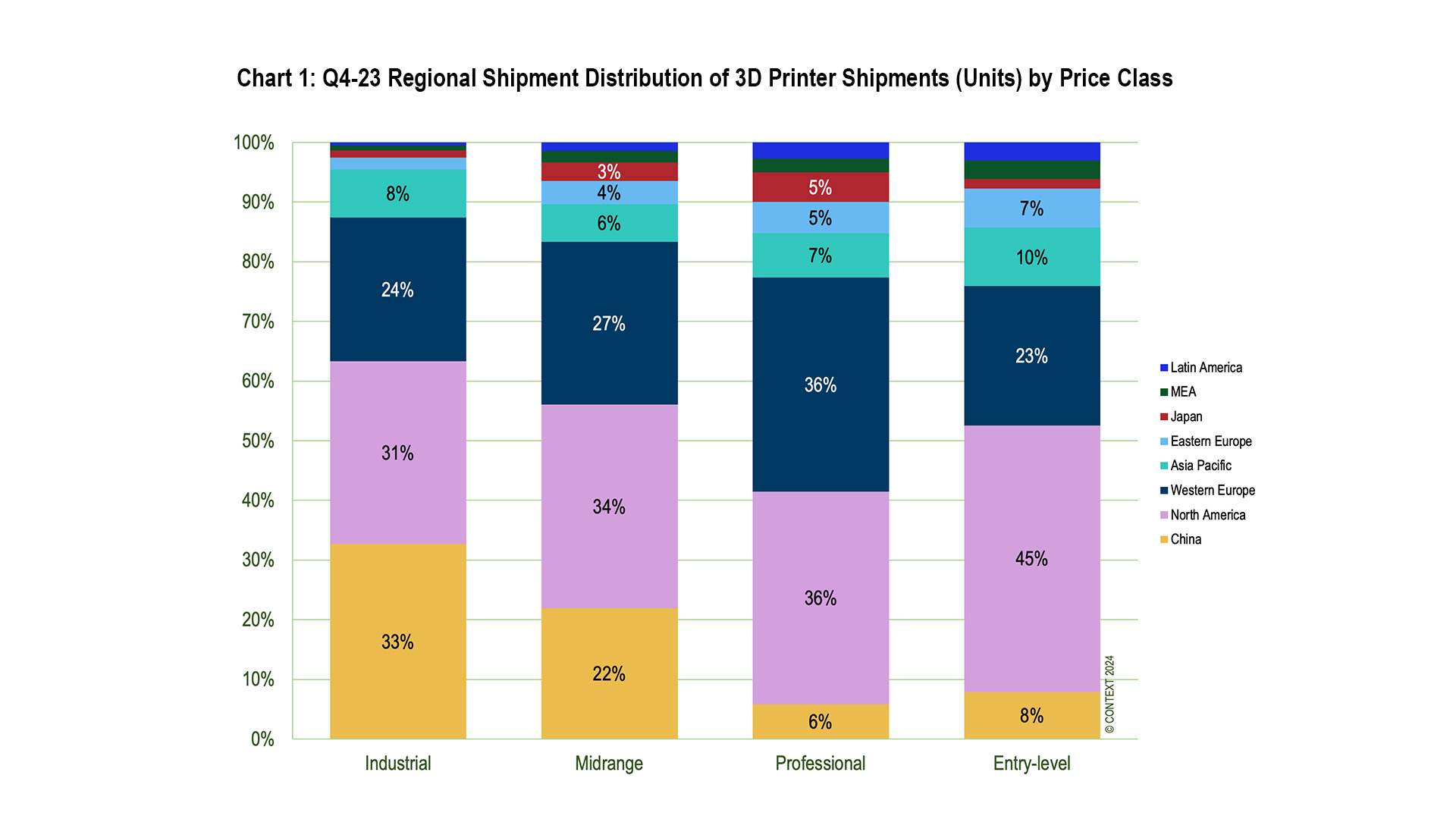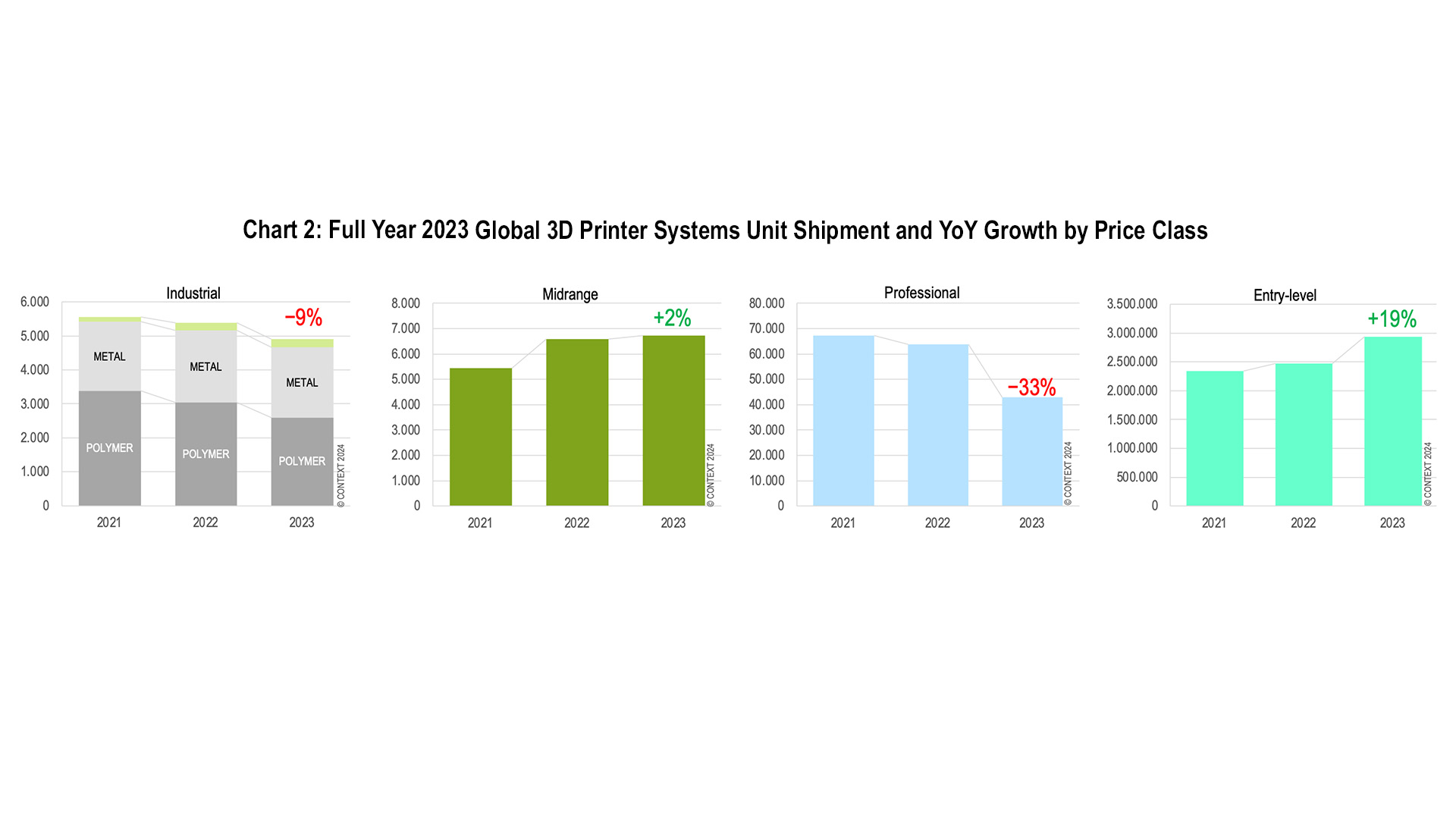London, 17 April 2024 – The fourth quarter of 2023
was a difficult period for many systems’ manufacturers across the
global 3D printer landscape with printer shipments across three of the
four main price–classes falling from a year ago, according to the
latest market intelligence from CONTEXT.
Traditionally, around 30% of all 3D printers
sold each year are shipped in the fourth quarter. This trend was
bucked in Q4 2023 against a global landscape marked but shifting
buying patterns, sticky inflation and the high–cost of capital.
While there was a small (1%) quarter–on–quarter
(QoQ) increase for global Industrial price–class ($100K+) printer
shipments in Q4– 23, volumes were down –13% from Q4–22 as high
interest rates across the globe led to businesses waiting for the rate
decreases before investing in new capital equipment. Struggling with
similar issues seen from Industrial printers, Midrange ($20–$100K)
printer shipments were down –7% year–on–year (YoY.) Shipments of
Professional ($2.5–$20K) models dropped by –32% as companies impacted
by “sticky” inflation sought out cheaper alternatives. This had a
positive effect on sales of Entry–level printers costing less than
$2,500 – however, with shipments of these products up 35% YoY.
In spite of inconsistent regional economic
growth and recovery, many aspects of key economies around the globe
remain positive. We’re seeing strong GDP growth projections for
China and stronger than expected GDP growth and high stock market
levels in the US for example. All indications are that demand has
simply shifted out.
In aggregate across all price–classes, North
America is still the biggest market for 3D printers with shipments to
this region generating 41% of all systems’ revenues in Q4 2023. For
comparison, shipments into Western Europe were responsible for 26% of
revenues and those in China for 18%. Of these three leading regions,
the market in China has seen the most growth recently and it remains
the top market for the all–important Industrial price–class. From a
unit shipment perspective, 33% of the global shipment total for
Industrial price–class printers in the period were shipped into
domestic China. China’s dominance in the metals space is even more
impressive with 43% of the global shipment total of Industrial Metal
3D Printers shipped in the last quarter shipped there. Most of this
huge demand is met by domestic suppliers.

INDUSTRIAL SYSTEMS
This price category remains key, accounting for
just over 50% of all systems’ revenues in 2023. The fourth quarter saw
global Industrial shipments drop –13% YoY largely due to a –25% drop
in polymer systems with particular weakness in the polymer vat
photopolymerization space. UnionTech (in China) and 3D Systems
(predominantly in the West) both experienced falls in sales of vat
photopolymerisation machines. Shipments of Industrial metals printers
were actually up 4% because of growth of the powder bed fusion (PBF)
market in China and increasing sales of directed energy deposition
(DED) systems worldwide. For the full year, this price–class has been
severely impacted by reductions in capital expenditures (due to high
interest rates), resulting in aggregate shipments of Industrial
systems dropping –9% from 2022.
INDUSTRIAL METAL SYSTEMS
Although shipments of Directed Energy Deposition
(DED) systems grew by 30% YoY in Q4 2023, Powder Bed Fusion (PBF) was
still the most common metal technology in class, representing 72% of
all Industrial metal additive manufacturing (AM) machines shipped in
Q4–23. An overall fall of –1% in shipments of PBF systems in Q4 masks
the detail that while unit shipments were down in North America and
Europe, shipments were up YoY in China.
Chinese vendors had a weak Q3 last year but
bounced back in Q4, shipping 25% more PBF printers that a year ago
(mostly to their home region). Indeed, the four top shippers of
metal PBF printers in the period – BLT, Farsoon, Eplus3D and HBD –
were all Chinese and three of these saw YoY increases: 3% for BLT,
23% for Farsoon and a sizable YoY shipment jump of 100%+ for
Eplus3D. Over half (52%) of all Industrial metal PBF printers
dispatched worldwide now come from vendors based in China. Western
vendors in the space saw unit shipments drop –20% from Q4–22. For
the full year, Industrial Metal system shipments dropped –3% as
fewer Metal Powder Bed fusion systems shipped globally in 2023 than
in 2022. Other metal modalities, including Directed Energy
Deposition (DED) and Binder Jetting saw healthy or moderate growth
(up 15% and 2% respectively.)
INDUSTRIAL POLYMER SYSTEMS
Vat photopolymerisation shipments fell by –39%
YoY in Q4 2023 as the two leading companies both faced challenges.
Shanghai’s UnionTech, which has a 49% share of
this category, principally sells into mainland China and is still
seeing an uneven recovery from Covid lockdowns in H1 2022 that have
left shipments fluctuating unevenly from quarter to quarter.
The Western leader in the category – 3D Systems
– continued to be challenged by weak demand from dentistry, its key
end–market for this technology. Economic pressures have shifted
consumer spending away from cosmetic dental procedures so few
companies in the sector are investing in new machines.

MIDRANGE SYSTEMS
In Q4 2023, unit shipments of Midrange systems
were up 16% sequentially but fell –7% on the previous year. The
category was a bit of mixed bag with shipments from half the vendors
falling YoY while the those from the other half were flat or
increasing. Among those who had a successful quarter were:
UnionTech, whose domestic Vat Photopolymerization shipments were
strong throughout the year and continued to grow; Flashforge, who
saw increased demand for their WaxJet printer; and Nexa3D, which
benefitted from the Polymer Powder Bed Fusion business it acquired
from XYZprinting.
Over the year as a whole, the category leaders
were Stratasys (once again), UnionTech and Formlabs. UnionTech and
Formlabs led growth in the category. While these two vendors enjoyed
impressive yearly growth in the category (of 88% and 123%
respectively) the overall segment only saw a marginal YoY growth of
2%. Stalwarts Stratasys, 3D Systems and Markforged all saw a
double-digit percentage drop in unit shipments of Midrange machines
in 2023. Key drivers in 2023 were Formlabs, who successfully created
a market for new low–end polymer PBF models, and UnionTech which
focused their attentions on the growing China market.
PROFESSIONAL SYSTEMS
The last quarter of 2023 was another difficult
one for products in this price–class. While shipments of
Professional 3D printers were 21% higher than in Q3, they were down
YoY for a ninth consecutive quarter. Share shifts in this period of
globally high inflation have not been so much within the price–class
as between this class and the one below. Professional buyers have
recognised that Entry– level products, once perceived as being for
only for consumers, offer similar functionality to models in this category.
Shipments over the full year dropped
precipitously, falling by –33% YoY. Every vendor in the global top
10 – with the exception of start–up Nexa3D – shipped fewer printers
in 2023 than in 2022. Over recent years, manufacturers of
Professional printers have been able to maintain or increase
revenues even as unit sales have fallen by offering new features and
raising prices. This strategy proved to be less effective in 2023 as
inflation changed end–market purchasing habits however. Key vendors
historically focused on this price–class, including UltiMaker,
Formlabs and Raise3D, are now poised for product expansions and are
aiming to reverse market trends in the coming year.
ENTRY-LEVEL SYSTEMS
Nearly a million (993K) Entry–level 3D printers
were shipped worldwide in Q4 2023 – a new quarterly record! Although
Creality’s shipment increase in the quarter of 38% YoY was impressive,
Bambu Lab’s 3000% growth stands out and was one of the main
contributing factors to the performance of the category overall. If
these two vendors are excluded from the data, shipment growth in this
price–class was only 2%. While some companies, such as Flashforge,
also experienced nice levels of growth (36%), others saw shipments
drop (by –51% in the case of Toybox, for example).
For the full year, shipments rose 19% from 2022
with global inflation ironically expanding the market base for this
type of printer. 94% of Entry–level printers shipped in 2023 came from
Chinese vendors (up from 88% in 2019) and 89% came from just four
vendors: Creality, Anycubic, Elegoo and Bambu Lab.
OUTLOOK
As Q1 2024 came to a close, many forecasts for
2024 remained conservative. While we expect the projections of
Industrial–focused players in particular to remain cautious as they
wait to see how interest rates change across the globe, many see
strong signs of pent–up demand. GE Additive – part of the newly
separated GE Aerospace – has earmarked a good portion of its announced
$650M 2024 spend for additive. Other US companies have reported
increased demand from defence customers thanks to new federal
government investment. In China, UnionTech has announced plans to
further expand their product portfolio in 2024 on top of their recent
expansion from polymers into metals.
Forecasts for total worldwide shipments in 2024
predict single–digit percentage unit growth in all price–classes
(Industrial 5%, Midrange 4%, Professional 3%, Entry–level 8%), rising
to double–digit percentage growth by 2025 (2024 to 2025 forecasts are
Industrial 16%, Midrange 12%, Professional 13%, Entry–level 11%).
However, the hope is that the pent–up demand seen on the horizon can
be pulled–into 2024.
* Price–class groups: Industrial $100,000+;
Midrange $20,000–$100,000; Professional $2,500–$20,000; Entry–level
<$2,500 (combines former Personal and Kit&Hobby classes).